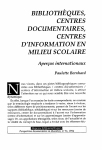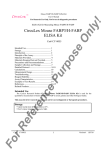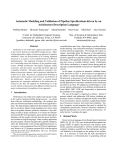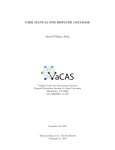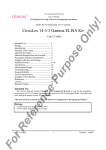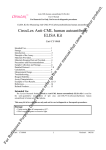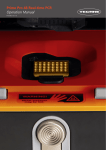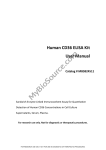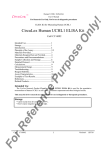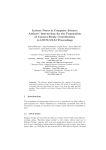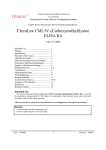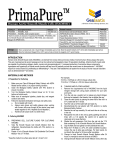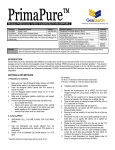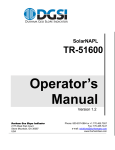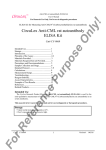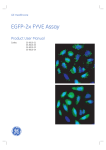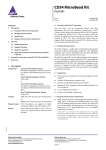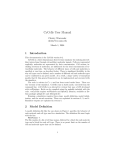Download Data Sheet
Transcript
CD36/HEK293 Cell Line User’s Manual For Research Use Only, Not for use in diagnostic procedures Human CD36-expressing HEK293 Cell Line ly ! TM On CircuLex CircuLex CD36/HEK293 Cell Line Intended Use Pu rp Intended Use.........................................................1 Storage .................................................................1 Introduction .........................................................2 List of Components..............................................2 Shipping and Storage.............................................2 Safety Guideline...................................................3 Required Media for CD36/HEK293 Cell Line.....3 Thawing Cells........................................................3 Subculturing Cells.................................................4 Preparation of frozen cell stock cell.....................4-5 Character of CD36/HEK293 Cell Line.................5 References.............................................................6 Related Product.....................................................7 os e Cat# CY-C8251 en ce The CycLex Research Product CircuLex CD36/HEK293 Cell Line was designed for studying CD36 signaling pathway. The cell line was derived from HEK293 cell line, stably expressing human CD36, which has 6X his tagged at C-terminus. Applications for this cell line include: 1) Screening inhibitors of CD36-ligand interaction on cell surface. 2) Detecting autoantibodies for CD36. This cell line is for research use only and not for use in diagnostic or therapeutic procedures. er Storage rR ef • Upon receipt store at liquid N2. See Shipping and Storage section, page 2. Fo Cat#: CY-C8251 1 Version#: 120420 TM CD36/HEK293 Cell Line User’s Manual For Research Use Only, Not for use in diagnostic procedures On Introduction ly ! CircuLex os e CD36, the defining member of macrophage scavenger receptor class B, is a highly glycosylated, single chain 88-kDa protein that binds oxidized low-density lipoprotein (Ox-LDL), fatty acids, anionic phospholipids including phosphatidylinositol and phosphatidylserine, and the proteins collagen and thrombospondin (1–5). As a result of the broad ligand specificity of CD36, multiple roles for this protein have been proposed. In vitro and in vivo studies indicate that CD36 mediates a significant proportion of binding and internalization of Ox-LDL by tissue-differentiated macrophages (6–8). Thus CD36 is believed to play a critical role in atherogenesis through its ability to bind and internalize Ox-LDL trapped in the arterial wall, thereby facilitating foam-cell formation (9, 10). In response to glucose, increases in peroxisome–proliferator-activated receptor-γ (PPAR-γ) might lead to an increase in macrophage expression of CD36 and contribute to accelerated atherosclerosis (11). Consistent with this, expression of CD36 on the surface of monocytes and macrophages is upregulated by oxidized LDL, as well as by hyperglycemia and conditions associated with the metabolic syndrome. rp Components Pu The CD36/HEK293 Cell Line is supplied in one vial containing approximately 2 × 106 cells in 1 ml of freezing medium (complete growth medium w/ 10% Dimethyl sulfoxide, DMSO). 1 ml of CD36/HEK293 Cell Line (~2 × 106 cells) en ce Shipping and Storage rR ef er The CD36/HEK293 Cell Line is shipped frozen on dry ice. It is strongly recommended that the CD36/HEK293 Cell Line shall be thawed and propagated as soon as possible following receipt (see “Thawing the CD36/HEK293 Cell Line” protocol below). If long-term storage of the frozen cells is required, place vial in the vapor phase of liquid nitrogen. Storage of cells directly in liquid nitrogen requires use of protective tubing, such as Nunc Cryoflex™ Tubing. Storage of cells at -80°C is suitable only for short periods of time (a few months), and may result in loss of viability and is not recommended. Fo Cat#: CY-C8251 2 Version#: 120420 TM CD36/HEK293 Cell Line User’s Manual For Research Use Only, Not for use in diagnostic procedures On Safety Guidelines ly ! CircuLex This product contains Dimethyl sulfoxide (DMSO), a hazardous material. It is also important to always follow standard tissue culture practices, which include: os e • Wearing gloves, safety glasses, and a lab coat at all times when conducting the procedure • Carefully performing all procedures to minimize the creation of aerosols or splashes Required Media for CD36/HEK293 Cell Line The list below shows the recommended complete medium and freezing medium for maintenance of the CD36/HEK293 Cell Line. Pu Thawing Cells rp • D-MEM, high glucose • 10 % fetal bovine serum (FBS) • 2 mM L-glutamine • 1 % Penicillin/Streptomycin (10,000 I.U. Penicillin and 10,000 μg/ml Streptomycin) • 200 µg/ml of G418 Use the following protocol to thaw the CD36/HEK293 Cell Line to initiate cell culture. The initial propagation of cells should be used to generate stocks to be frozen and stored for future use. en ce 1. Remove the frozen vial of cells from liquid nitrogen and quickly thaw them by swirling in a 37°C water bath. Try to keep the O-ring and cap of the vial out of the water, to prevent possible contamination. Wear eye protection. 2. Before the cells are completely thawed, remove from 37°C water bath and decontaminate outside of the vial with 70 % ethanol. 3. Using sterile techniques, transfer the cells to a T-75 cm2 tissue culture flask containing 15 ml of complete medium at room temperature. Transfer entire contents of the vial to the T-75 flask, and do not pipette cells up and down as this may kill the cells. er 4. Swirl the T-75 flask to evenly distribute cells. Incubate the flask at 37°C, 5 % CO2 overnight to allow cells to attach to the bottom of the flask. ef 5. The following day, pour off or aspirate off medium and replace with 15 ml fresh complete medium at room temperature. 6. Incubate the cells at 37°C, 5 % CO2 and check daily until they reach 85-95 % confluency (about 2-4 days). rR 7. Once the cells reach 85-95 % confluency, subculture the cells as described below. For the initial culture, it is recommended to archive several frozen stocks and continue to propagate remainder of cells for use in experiments. Note: Vials inappropriately stored directly in liquid nitrogen without protective tubing, such as Nunc Cryoflex™ Tubing, may contain liquid nitrogen. Upon thawing, the liquid nitrogen will quickly Fo Cat#: CY-C8251 3 Version#: 120420 TM CD36/HEK293 Cell Line User’s Manual For Research Use Only, Not for use in diagnostic procedures ly ! CircuLex On convert to the gas phase and may cause the vial of cells to explode. This is a very hazardous situation, and should only be performed using protective gloves and clothing, and a full-face mask. To avoid this situation, store vials only in the vapor phase of liquid nitrogen or use the protective tubing described above if the vial must be stored directly in the liquid phase of liquid nitrogen. os e Subculturing Cells When the cells reach 85-95 % confluency, they are ready to be subcultured, or transferred to a new tissue culture flask. This is typically every 2-3 days. Use the following protocol to subculture the cells grown in a T-75 cm2 flask. If a different sized tissue culture flask is being used, scale the reagent and media volumes accordingly. rp 1. Remove complete medium from the flask by pouring or aspiration. Wash the cells once with 5 ml PBS to remove excess medium, and discard PBS. Complete medium containing FBS will inhibit trypsin. Pu 2. Add 5 ml of pre-warmed (room temperature to 37°C) trypsin-EDTA (0.5 % trypsin with EDTA-2Na) solution to the cell monolayer and incubate for 5 minutes at 37°C, 5 % CO2, or until cells detach. If cells are still attached after 5 minutes, swirl the flask gently and incubate a few minutes longer. 3. Add 5 ml of complete medium and gently pipette up and down to break up cell clumps and achieve a suspension of single cells. Transfer the cell suspension to a 15 ml sterile, conical centrifuge tube. 4. Determine viable and total cell counts by use of a hemocytometer chamber or a Coulter Counter. en ce 5. Dispense 1 ml of the cell suspension into each new T-75 cm2 flask containing 20 ml of pre-warmed medium. This is a 1:10 split (1/10) of the original cell population. Cells should be 85-95 % confluent after 2 to 3 days. If using a culture flask other than a T-75 cm2, scale the volume of cell suspension used. If cells are to be used for an experimental assay, seed cells at the required density for the experiment. 6. Incubate the cells at 37°C, 5 % CO2 until 85-95 % confluent and subculture again, or incubate until they reach the desired confluency for the experiment. Preparation of frozen cell stocks er Before beginning the freezing protocol below, label all cryovials and prepare freezing medium (complete growth medium with 10 % DMSO). Keep freezing medium at 4°C or on ice until ready for use. ef 1. Culture a T-75 cm2 flask of the cells to 85-95 % confluency. rR 2. Remove the cells from the flask by following steps 1 through 5 in “Subculturing CD36/HEK293 Cell Line”, above. 3. Centrifuge the remaining cell suspension at 250 × g for 10 minutes at room temperature. Aspirate the medium from the cells and resuspend the pelleted cells in 1 ml of freezing medium for every 1 ml of original cell suspension (e.g., if the cells retrieved from the original T-75 cm2 flask are resuspended in 10 ml and 1 ml is used for subculturing, centrifuge the remaining 9 ml of cells, aspirate medium, and resuspend in 9 ml of freezing medium. If more or less cell suspension is used, adjust the volume of Fo Cat#: CY-C8251 4 Version#: 120420 TM CD36/HEK293 Cell Line User’s Manual For Research Use Only, Not for use in diagnostic procedures ly ! CircuLex On freezing medium accordingly). Each T-75 cm2 flask at 85-95 % confluency will yield approximately ten (10) of 1 ml aliquot for freezing. 4. Dispense the 1 ml aliquots of the cells into cryovials following manufacturer’s recommendations. os e 5. Freeze cells using either a controlled-rate freezing apparatus or manually using a freezing container. The apparatus should provide a controlled freezing rate of 1°C/minute. Cells should be frozen to -70°C to -80°C overnight. 6. Transfer frozen cell stocks to liquid nitrogen storage the following day. Character of CD36/HEK293 Cell Line rp Fig.1 Flow cytometry analysis of CD36/HEK293 Cell Line using anti-CD36 mAb and isotypic mouse IgG control Pu CD36/HEK293 Cell Line were detached, washed, incubated with 5 µg/ml anti-CD36 mAb for 1 h at 4 °C, washed, then incubated with Alexa 488 conjugated anti-mouse IgG antibody for 45 min at 4 °C, and then resuspended in PBS and analyzed in the FACScan with LysisII software. en ce Isotypic IgG control rR ef er Anti-CD36 mAb Fo Cat#: CY-C8251 5 Version#: 120420 CD36/HEK293 Cell Line User’s Manual For Research Use Only, Not for use in diagnostic procedures References ly ! TM On CircuLex 1. Endemann, G., Stanton, L. W., Madden, K. S., Bryant, C. M., White, R. T., and Protter, A. A. (1993) J. Biol. Chem. 268, 11811–11816 2. Oquendo, P., Hundt, E., Lawler, J., and Seed, B. (1989) Cell 58, 95–101 os e 3. Tandon, N. N., Kralisz, U., and Jamieson, G. A. (1989) J. Biol. Chem. 264, 7576–7583 4. Silverstein, R. L., Asch, A. S., and Nachman, R. L. (1989) J. Clin. Invest. 84, 546–552 5. Greenwalt, D. E., Lipsky, R. H., Ockenhouse, C. F., Ikeda, H., Tandon, N. N., and Jamieson, G. A. (1992) Blood 80, 1105–1115 rp 6. Nicholson, A. C., Frieda, S., Pearce, A., and Silverstein, R. L. (1995) Arterioscler. Thromb. Vasc. Biol. 15, 269–275 Pu 7. Huh, H. Y., Pearce, S. F., Yesner, L. M., Schindler, J. L., and Silverstein, R. L. (1996) Blood 87, 2020–2028 8. Nozaki, S., Kashiwagi, H., Yamashita, S., Nakagawa, T., Kostner, B., Tomiyama, Y., Nakata, A., Ishigami, M., Miyagawa, J., Kameda-Takemura, K., Kurata, Y., and Matsuzawa, Y. (1995) J. Clin. Invest. 96, 1859–1865 en ce 9. Huh, H. Y., Pearce, S. F., Yesner, L. M., Schindler, J. L. and Silverstein, R. L. (1996) Blood 87, 2020-2028 10. Nakata, A., Nakagawa, Y., Nishida, M., Nozaki, S., Miyagawa, J. I., Nakagawa, T., Tamura, R., Matsumoto, K., Kameda-Takemura, K., Yamashita, S. and Matsuzawa, Y. (1999) Arterioscler. Thromb. Vasc. Biol. 19, 1333-1339 rR ef er 11. Spiegelman, A. (1998) Cell 93, 153–155. Fo Cat#: CY-C8251 6 Version#: 120420 CD36/HEK293 Cell Line User’s Manual For Research Use Only, Not for use in diagnostic procedures Related Products en ce Pu rp os e * RAGE/HEK293 cell line: Cat# CY-C8250 * CD36/HEK293 cell line: Cat# CY-C8251 * N-epsilon Carboxymehtyl Lysine-BSA : Cat# CY-R2052 * N-epsilon Carboxymehtyl Lysine-OVA: Cat# CY-R2053 * Glucose-AGE-BSA: CY-R2056 * Glucose-AGE-OVA: CY-R2057 * Glyceraldehyde-AGE-BSA: Cat# CY-R2058 * Glyceraldehyde-AGE-OVA: Cat# CY-R2059 * Glycolaldehyde-AGE-BSA: Cat# CY-R2060 * Glycolaldehyde-AGE-OVA: Cat# CY-R2061 * Methylglyoxal-AGE-BSA: Cat# CY-R2062 * Methylglyoxal-AGE-OVA: Cat# CY-R2063 * Glyoxal-AGE-BSA: Cat# CY-R2064 * Glyoxal-AGE-OVA: Cat# CY-R2065 * CML-HSA-N-epsilon (carboxymethyl) Lysine-HAS: Cat# CY-R2066 * CEL-HSA-N-epsilon (carboxyethyl) Lysine-HAS: Cat# CY-R2067 ly ! TM On CircuLex PRODUCED BY ef er CycLex Co., Ltd. 1063-103 Terasawaoka Ina, Nagano 396-0002 Japan Fax: +81-265-76-7618 e-mail: [email protected] URL: http://www.cyclex.co.jp rR CycLex/CircuLex products are supplied for research use only. CycLex/CircuLex products and components thereof may not be resold, modified for resale, or used to manufacture commercial products without prior written approval from CycLex Co., Ltd.. To inquire about licensing for such commercial use, please contact us via email. Fo Cat#: CY-C8251 7 Version#: 120420







